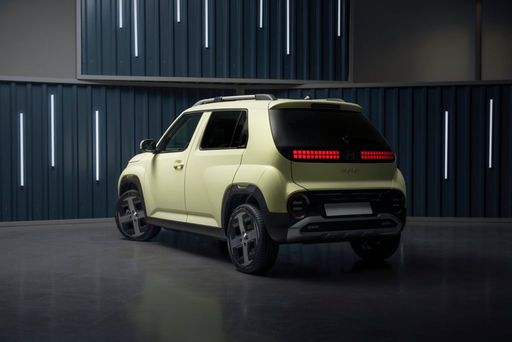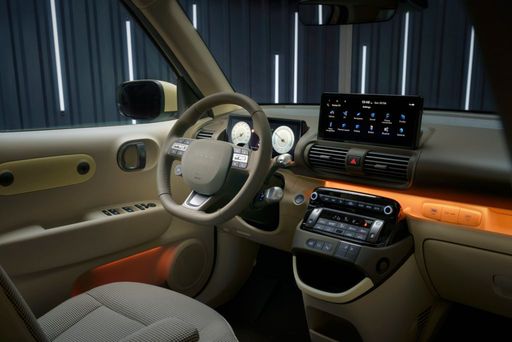Hyundai Inster vs Renault R4 - Differences and prices compared
Costs and Efficiency:
Looking at overall running costs, both models reveal some interesting differences in everyday economy.
Hyundai Inster has a clearly perceptible advantage in terms of price – it starts at 20500 £, while the Renault R4 costs 25200 £. That’s a price difference of around 4715 £.
In terms of energy consumption, the advantage goes to the Renault R4: with 14.20 kWh per 100 km, it’s hardly perceptible more efficient than the Hyundai Inster with 14.30 kWh. That’s a difference of about 0.10 kWh.
As for range, the Renault R4 performs slight better – achieving up to 409 km, about 39 km more than the Hyundai Inster.
Engine and Performance:
Under the bonnet, it becomes clear which model is tuned for sportiness and which one takes the lead when you hit the accelerator.
When it comes to engine power, the Renault R4 has a evident edge – offering 150 HP compared to 115 HP. That’s roughly 35 HP more horsepower.
In acceleration from 0 to 100 km/h, the Renault R4 is evident quicker – completing the sprint in 8.20 s, while the Hyundai Inster takes 10.60 s. That’s about 2.40 s faster.
In terms of top speed, the performs better – reaching , while the tops out at . The difference is around .
There’s also a difference in torque: Renault R4 pulls clearly perceptible stronger with 245 Nm compared to 147 Nm. That’s about 98 Nm difference.
Space and Everyday Use:
Beyond pure performance, interior space and usability matter most in daily life. This is where you see which car is more practical and versatile.
Seats: Renault R4 offers to a small extent more seating capacity – 5 vs 4.
In curb weight, Hyundai Inster is hardly perceptible lighter – 1380 kg compared to 1485 kg. The difference is around 105 kg.
In terms of boot space, the Renault R4 offers evident more room – 420 L compared to 280 L. That’s a difference of about 140 L.
In maximum load capacity, the Renault R4 performs evident better – up to 1405 L, which is about 346 L more than the Hyundai Inster.
When it comes to payload, Renault R4 to a small extent takes the win – 443 kg compared to 357 kg. That’s a difference of about 86 kg.
Who wins the race?
The Renault R4 proves to be wins the duel decisively and therefore becomes our DriveDuel Champion!
Renault R4 is the better all-rounder in this comparison.

Renault R4
Costs and Consumption
View detailed analysis
Engine and Performance
View detailed analysis
Dimensions and Body
View detailed analysis
Hyundai Inster
The Inster has quickly captured the attention of automotive enthusiasts with its striking design and dynamic performance. This model seamlessly blends advanced technology with comfort, making it an ideal choice for both daily commutes and adventurous road trips. With its spacious interior and innovative features, the Inster promises an exhilarating driving experience that doesn’t compromise on practicality.
details @ Hyundai Motor Company
@ Hyundai Motor Company
 @ Hyundai Motor Company
@ Hyundai Motor Company
 @ Hyundai Motor Company
@ Hyundai Motor Company
Renault R4
The Renault R4, affectionately known as the "R4," is a quintessential symbol of French automotive simplicity and practicality. This classic compact car, originally introduced in the early 1960s, won over numerous enthusiasts with its versatile design and dependable performance. Its no-frills charm and robust build made it a beloved choice for rural drivers and city dwellers alike, cementing its status as an iconic piece of automotive history.
details
 @ Hyundai Motor Company
@ Hyundai Motor Company
|
|
|
|
|
Costs and Consumption |
|
|---|---|
|
Price
20500 - 25800 £
|
Price
25200 - 31200 £
|
|
Consumption L/100km
-
|
Consumption L/100km
-
|
|
Consumption kWh/100km
14.3 - 15.1 kWh
|
Consumption kWh/100km
14.2 - 15.1 kWh
|
|
Electric Range
327 - 370 km
|
Electric Range
308 - 409 km
|
|
Battery Capacity
42 - 49 kWh
|
Battery Capacity
40 - 52 kWh
|
|
co2
0 g/km
|
co2
0 g/km
|
|
Fuel tank capacity
-
|
Fuel tank capacity
-
|
Dimensions and Body |
|
|---|---|
|
Body Type
SUV
|
Body Type
SUV
|
|
Seats
4
|
Seats
5
|
|
Doors
5
|
Doors
5
|
|
Curb weight
1380 - 1433 kg
|
Curb weight
1485 - 1537 kg
|
|
Trunk capacity
238 - 280 L
|
Trunk capacity
420 L
|
|
Length
3825 - 3845 mm
|
Length
4144 mm
|
|
Width
1610 mm
|
Width
1808 mm
|
|
Height
1575 - 1610 mm
|
Height
1552 mm
|
|
Max trunk capacity
1059 L
|
Max trunk capacity
1405 L
|
|
Payload
317 - 357 kg
|
Payload
410 - 443 kg
|
Engine and Performance |
|
|---|---|
|
Engine Type
Electric
|
Engine Type
Electric
|
|
Transmission
Automatic
|
Transmission
Automatic
|
|
Transmission Detail
Reduction Gearbox
|
Transmission Detail
Reduction Gearbox
|
|
Drive Type
Front-Wheel Drive
|
Drive Type
Front-Wheel Drive
|
|
Power HP
97 - 115 HP
|
Power HP
122 - 150 HP
|
|
Acceleration 0-100km/h
10.6 - 11.7 s
|
Acceleration 0-100km/h
8.2 - 9.2 s
|
|
Max Speed
140 - 150 km/h
|
Max Speed
150 km/h
|
|
Torque
147 Nm
|
Torque
225 - 245 Nm
|
|
Number of Cylinders
-
|
Number of Cylinders
-
|
|
Power kW
71 - 85 kW
|
Power kW
90 - 110 kW
|
|
Engine capacity
-
|
Engine capacity
-
|
General |
|
|---|---|
|
Model Year
2025
|
Model Year
2025
|
|
CO2 Efficiency Class
A
|
CO2 Efficiency Class
A
|
|
Brand
Hyundai
|
Brand
Renault
|
What drivetrain options does the Hyundai Inster have?
Available configurations include Front-Wheel Drive.
The prices and data displayed are estimates based on German list prices and may vary by country. This information is not legally binding.
